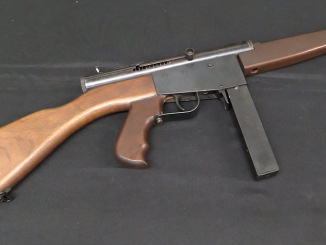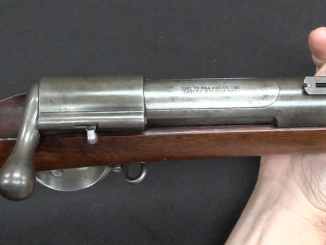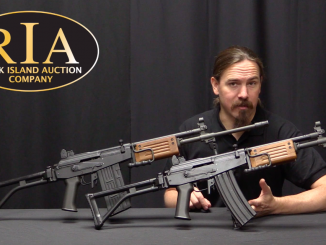Uruguay first adopted a Mauser rifle in the 1880s, with the single-shot Mauser model 1871. After an abortive attempt to update those rifles to a small bore smokeless powder cartridge (the Dovitiis conversion), they opted to purchase Mauser 95s from DWM in the new (and excellent) 7x57mm Mauser cartridge. This was followed by an order of Model 98 Mausers in 1908, both standard rifles and short rifles. Today’s rifle is an M1908 Uruguayan short rifle, one of 1,500 delivered in 1911, and one of 4,000 purchased overall by Uruguay.
However, there is more to this rifle than just being a rare variation of South American Mauser. In 1912, it was acquired by the Winchester Repeating Arms Company and put into their reference collection. Winchester wanted to stay current on rifle and ammunition developments elsewhere in the industry, and this rifle was specifically labelled as an exemplar of the 7mm “pointed” cartridge from DWM.




Is is possible that Winchester was involved in making ammunition for Uruguay, or the tooling to make the ammunition, or quoting on doing so, and that this rifle was supplied by Uruguay to Winchester for testing the ammunition prototypes? That would explain how the rifle got from Uruguay to Winchester so quickly.
Fantastic to see a South American Mauser in such excellent preservation. A time capsule of the high quality finishing from DWM (and the other plants producing Mausers).
It’s interesting how the receiver ring looks like it had a rough evening with a hammer, before it got its crest and went for case hardening.
Those dents aren’t evident on any other part of the gun.
What does the big “B” engraved on the rifle stand for? There is one on my Brazillian Mauser too. I thought it was for “Brazil”.
D. Potter , in Candada
I meant ” CANADA”
This is just a guess, but it may have referred to the then-head of state;
It was fairly common in Latin American countries for presidents or etc. to create “personality cults” around themselves. (It still is, for that matter.)
The “B” may have been an example of such a principle; the Maximum Leader putting his “brand” on the rifle issued to his troops to reinforce their loyalty.
The parallel with the Imperial chrysanthemum on the breech ring of every Arisaka rifle manufactured is obvious. “This rifle belongs to the Emperor- and so do you who wield it in his name”.
As I said, just a guess.
cheers
eon
But why Brazil too?
Aparicio Saravia was mortally wounded by Mauser bullets. La República Oriental del Uruguay (the “East side/shore”) was created thanks to British intervention into the ongoing tussle between Imperial Brazil and the Argentine Confederation over the Río de la Plata and where at the time a very great many of cattle browsed over the “purple land.” Britain had huge trading interests in both Argentina and Brazil, and so while the Emperor desired a Spanish-speaking southernmost province of “Cisplatina,” the Spanish-speaking inhabitants wanted support from the Argentine Confederation to accomplish something like the old “League of Free Peoples” envisioned by José Gervasio Artigas–driven out by Brazilian troops and basically under exile/house arrest in nearby Paraguay. Britain wanted a “buffer state” between the two giants. Throughout the 19th century, Uruguay was a basket case with Argentine caudillos like Rosas–the “illustrious American”–favoring rural landed property interests, and Brazil often backing one or another faction like the Colorados associated with the port Montevideo. Countryside vs. city, basically. Originally, the rural party adopted white hat bands in battle, hence “blancos” while their city rivals adopted blue… But blue fades in the sun to a whitish color, so red was adopted, hence “Colorados” or “reds.” The Blancos laid siege to Montevideo from their capital in Cerro, while the defense of Montevideo was heralded throughout 19th century liberalism as an important cause… One Giuseppe Garibaldi led the Uruguayan navy and commanded largely Italian foreign volunteers. He’d earlier been in the Republican “ragamuffin war” against the Imperial crown in Brazil, and run off with a comely Brazilian lass who was already married to another… Garibaldi dressed “Gaucho style” for the remainder of his rather colorful and adventurous life.
As for the legacy of José Batlle y Ordóñez, Uruguayans would have us believe that he brought about a social revolution in the nation during the early 20th century, influenced as he was by Switzerland and Krausism and liberalism. “Batllismo” certainly laid the basis for many welfare-state reforms, an on-again/off-again collective executive–“plural executive”– instead of a single president (found incompatible with the Spanish patrimonialist model you describe…), and the right of women to vote in 1917 (although the first election in which women voted nationally was 1938).
Militarily, things went from Remington rolling blocks and single-shot Mausers, to 7mm Mauser–just like neighbor Brazil, but also Mexico, Chile, Venezuela, etc. Much the rest of the continent followed Argentina with 7.65x53mm: Bolivia, Peru, Colombia, etc. Today the gendarmerie has Kalashnikovs and the army AUGs, but doubtless a great many FALs and MP5s and even earlier arms are squirrled away.
During the urban guerrilla war in the late 1960s until the military regime in the early 1970s, the MLN-Tupamaros used arms seized from private shooting clubs and police stations, and also some arms obtained from raiding the navy or the army. Cuba may have given them 12 “Russian-capture” MP40 9mm SMGs. Meanwhile, the Uruguayan Communist Party received lavish arms and equipment from the Eastern Bloc, including many ex-ARVN M16s! These were all discovered when the “milicos” or military dictatorship decided to crush the party as part and parcel of squelching the urban guerrillas and de-politicizing the nation by force.
Highest meat-consumption per capita, by the way… More than Argentines!
“Uruguay(…)”
According to Uruguay by W. H. Koebel, available at Project Gutenberg https://gutenberg.org/ebooks/42452
It must be admitted that many revolutions in Uruguay are curious affairs. To one not in close touch with the national movements an outbreak of the kind may appear to burst forth spontaneously, whereas it has probably been anticipated by the Government as well as by the revolutionaries for months beforehand. In these days even the most casual insurrection is not to be effected without a certain amount of forethought. First of all financial sinews are indispensable, and, these once obtained, it follows that a supply of arms is equally essential.
The introduction of these is the most difficult feat of all to accomplish, since the Government adopts methods of precaution, and keeps a sharp look-out for any possible importations of the kind. Thus as a rule the weapons are either smuggled across the Brazilian frontier or over some of the more lonely stretches of the River Uruguay. Occasionally a device is tried similar to that which met with success in the Transvaal Colony previous to the South African War. When I was in Uruguay at the end of 1910 many indications were at hand that went to prove the imminence of a revolution, and the authorities, not only in Uruguay but in the neighbouring countries, were on the alert for any development that might arise. At this period a large number of innocent-looking packing-cases, purporting to contain Manchester goods, were in transit through Argentina destined for one of the northern Oriental ports on the Uruguay River. Through some cause or other the cases came under suspicion, and they were opened ere they had crossed the Argentine frontier. In place of the Manchester goods reposed thousands of grim Mauser rifles and millions of cartridges! The discovery of these weapons must have dealt a bitter blow to the insurrectionist cause; nevertheless, as anticipated, the revolution broke out a few weeks later.
Were these 7mm Uruuayan mode or some other? If 2nd which one exactly?
So the “B” probably stands for Brazil and this gun was made for Brazil in the first place, like my Brazilian long 7×57 1908.
Thanks!